- Forum
- categories
- Sanitation systems
- Faecal sludge management (FSM)
- Determining helminth egg quantities (measurement techniques)
- Software to identify and quantify pathogenic helminth eggs (National University of Mexico)
Software to identify and quantify pathogenic helminth eggs (National University of Mexico)
34.2k views
- Elisabeth
-
- User is blocked
- Freelance consultant since 2012
Less- Posts: 3372
- Karma: 54
- Likes received: 932
Re: Determining helminth egg quantities (measurement techniques)
Thanks for posting this publication of yours here, entitled "Identification and quantification of pathogenic helminth eggs using a digital image system". I can imagine it must be quite a milestone of this research project!
I am very pleased to see that it's an open access article, as it says at the top:
Open Access funded by Bill & Melinda Gates Foundation
Under a Creative Commons license (creativecommons.org/licenses/by/4.0/)
Awesome! (was it expensive to make it open access? Some journals charge quite a bit)
At the end of the article you state (bold formatting added by me):
Based on these results, it is important to select characteristics which appropriately describe the different types of helminth eggs commonly found in environmental samples to develop a suitable and reliable system to identify and quantify them. As shown in this research this has to be performed stepwise and therefore in order to add additional species other properties and algorithms might need to be added. The selection of more than 15 parameters (most of them described above as patent is pending) is the strength of the software in the sense that it prevents the eggs to be confused with other objects. This also ensures that even for similar species, some of those parameters will differ enough to be correctly classified. Also, it is expected that further steps in the system's development will increase its current capabilities and potential, including the addition of further parasites such as protozoa (e.g. Cryptosporidium spp., Giardia intestinalis, and Entamoeba histolytica). Moreover, future implementations of the software may use open-source libraries to allow the widespread use of these tool, especially in developing countries.
Could you please clarify for me the two sentences that you have highlighted in bold? How do you envision this patent to go together with making this software available to others. Would you licence it for a fee perhaps?
And have you had interest from other research groups to try out your method and software?
And how much longer is the funding from the Gates Foundation for?
Regards,
Elisabeth
Freelance consultant on environmental and climate projects
Please Log in to join the conversation.
You need to login to reply- TeamWTR
-
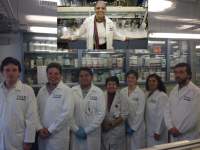 Topic Author
Topic Author- In the Global Development GCE Phase II, sponsored by Bill & Melinda Gates Foundation, we are the Water Treatment and Reuse Team. Our main project is to develop a software that will identify and quantify helminth eggs.
Less- Posts: 18
- Karma: 3
- Likes received: 10
Re: Key documents for the sub-category on determining helminth egg quantities (measurement techniques)
Please see the attachment below as well as a quick summary.
Jiménez, B., Maya, C., Velásquez, G., Torner, F., Arambula, F., Barrios, J. A., & Velasco, M. (2016). Identification and quantification of pathogenic helminth eggs using a digital image system. Experimental parasitology, 166, 164-172.
www.sciencedirect.com/science/article/pii/S0014489416300789
A system was developed to identify and quantify up to seven species of helminth eggs (Ascaris lumbricoides -fertile and unfertile eggs-, Trichuris trichiura, Toxocara canis, Taenia saginata, Hymenolepis nana, Hymenolepis diminuta, and Schistosoma mansoni) in wastewater using different image processing tools and pattern recognition algorithms.
The system development was based on the analysis of different properties of helminth eggs in order to discriminate them from other objects in samples processed using the conventional United States Environmental Protection Agency (US EPA) technique to quantify helminth eggs.
The system allows the helminth eggs most commonly found in wastewater to be reliably and uniformly detected and quantified. In addition, it provides the total number of eggs as well as the individual number by species, and for Ascaris lumbricoides it differentiates whether or not the egg is fertile.
We hope you find this information useful.
Best regards,
The Team UNAM, iingen.
Instituto de Ingeniería (Engineering Institute)
Universidad Nacional Autónoma de México, Mexico City.
E-mails
Blanca Jimenez: This email address is being protected from spambots. You need JavaScript enabled to view it.
Catalina Maya: This email address is being protected from spambots. You need JavaScript enabled to view it.
Jose Antonio Barrios: This email address is being protected from spambots. You need JavaScript enabled to view it.
Please Log in to join the conversation.
You need to login to reply- TeamWTR
-
 Topic Author
Topic Author- In the Global Development GCE Phase II, sponsored by Bill & Melinda Gates Foundation, we are the Water Treatment and Reuse Team. Our main project is to develop a software that will identify and quantify helminth eggs.
Less- Posts: 18
- Karma: 3
- Likes received: 10
Re: Software to identify and quantify pathogenic helminth eggs (University Universidad Nacional Autónoma de México (UNAM), Mexico)
As you noted, hookworms refers to a group for several helminths, so maybe this is why the graphic reflects these numbers for hookworms, also Ascaris being the “most important” helminth genera, doesn’t necessarily mean that it will have the most infections all over the world. The international literature reports Ascaris as one of the more widely distributed helminth in the world, which is maybe a consequence of it being such a resistant helminth. This are reasons for the genera to be one of the more studied worldwide, So yes, in a way you could say Ascaris is used as a “model” due to its characteristics and distribution.
Best regards,
the WTR Team
Instituto de Ingeniería (Engineering Institute)
Universidad Nacional Autónoma de México, Mexico City.
E-mails
Blanca Jimenez: This email address is being protected from spambots. You need JavaScript enabled to view it.
Catalina Maya: This email address is being protected from spambots. You need JavaScript enabled to view it.
Jose Antonio Barrios: This email address is being protected from spambots. You need JavaScript enabled to view it.
Please Log in to join the conversation.
You need to login to reply- Elisabeth
-
- User is blocked
- Freelance consultant since 2012
Less- Posts: 3372
- Karma: 54
- Likes received: 932
Re: Software to identify and quantify pathogenic helminth eggs (University Universidad Nacional Autónoma de México (UNAM), Mexico)
OK, now it's clearer, thanks a lot. So we are talking about 3.5 billion infections with helminths, not 3.5 billion infected people.
If we assume that a person has 1-2 types of helminths at a given time (so say: 1.5), then we could estimate that 2.33 billion people are infected with helminths worldwide (=3.5 divided by 1.5).
This matches quite well with the two estimates given in the Wikipedia article about helminthiasis of 1.5 - 2 billion people
(en.wikipedia.org/wiki/Helminthiasis#Infection_estimates)
And I have a comment to make about the graph that you had attached, i.e. this one:
Once again, India sticks out like a sore thumb above all other countries! I thought at first, yes that's because the population in India is so huge. But then I realised that the values on the y-axis have already been adjusted per inhabitant (or per 10^5 inhabitants to be precise)! So this is really bad for India.
Another observation is that hookworms are more prevalent than the other two worm species. I always thought that Ascaris is the main helminth species worldwide? Or is it just that in sanitation literature it is used so much as a "model" for all helminths and this has skewed my impression of its importance?
I actually had to double check what hookworms are. Of course I went to our trusted Wikipedia pages (which I have been working on improving together with James and Cati).
See:
en.wikipedia.org/wiki/Hookworm
Hookworms is actually a summary term for three individual species:
Three species of hookworms commonly infect humans: Ancylostoma duodenale, Necator americanus and Strongyloides stercoralis
If you feel lost with all these types of worms (and there are actually thousands of different types! Mind boggling), then do take a look at the improved Wikipedia page here:
en.wikipedia.org/wiki/Helminthiasis#Most_common
or here:
en.wikipedia.org/wiki/Helminthiasis#Neglected_tropical_diseases
This is stuff that I recently added to Wikipedia. If anyone spots any mistake, please tell me or edit the page yourself, please.
And I recently had a small break-through in my hunt for photos of helminthiasis: I got permission to use this image (which is from South Africa) in a Wikipedia page:
The photo caption says: This piece of intestine, blocked by worms, was surgically removed from a 3-year-old boy at Red Cross Children’s Hospital. The child survived, but no child should be subjected to such an easily preventable condition. Photo: Allen Jefthas
I am still looking for more (clinical) photos. If 2 billion people are infected with worms, there have to be more clinical photos around somewhere on someone's PC...
Regards,
Elisabeth
Freelance consultant on environmental and climate projects
Attachments:
-
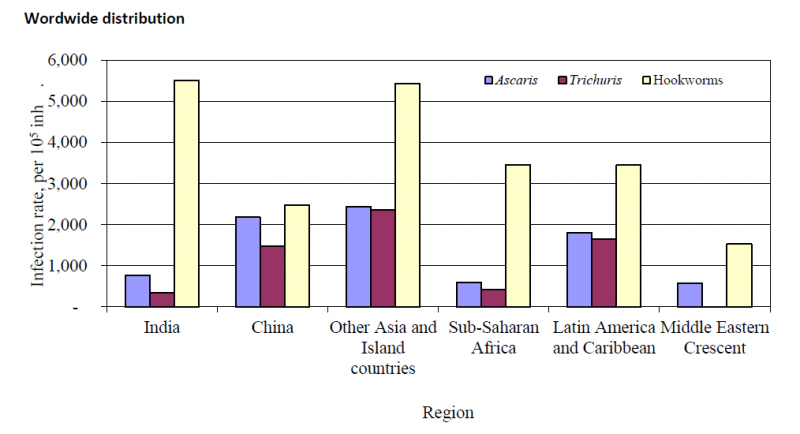 graphonhelminths.png
(Filesize: 190KB)
graphonhelminths.png
(Filesize: 190KB)
-
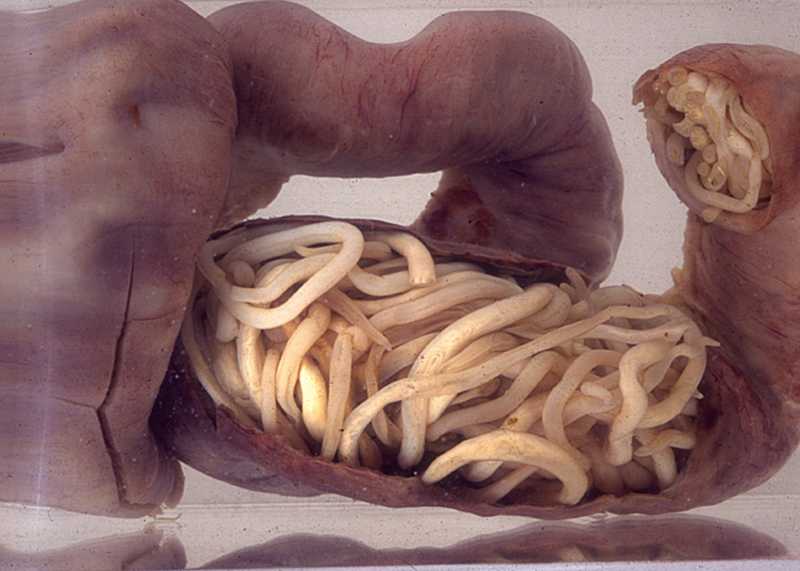 Nutritioni...0dpi.jpg
(Filesize: 39KB)
Nutritioni...0dpi.jpg
(Filesize: 39KB)
Please Log in to join the conversation.
You need to login to reply- TeamWTR
-
 Topic Author
Topic Author- In the Global Development GCE Phase II, sponsored by Bill & Melinda Gates Foundation, we are the Water Treatment and Reuse Team. Our main project is to develop a software that will identify and quantify helminth eggs.
Less- Posts: 18
- Karma: 3
- Likes received: 10
Re: Software to identify and quantify pathogenic helminth eggs (University Universidad Nacional Autónoma de México (UNAM), Mexico)
In developing countries geohelminth, infections are of major concern. The eggs of, especially, Ascaris and Taenia are persistent in the environment and are therefore regarded as an indicator and index of hygienic quality.
Reference:
WHO (2006) Safe Use of Wastewater Excreta and Greywater, Vol 4, p. 32
I am attaching a file with the table and added the total results at the bottom.
Please log in or register to see it.
Actually one person can be infected with more than one helminth. The important thing here is what you are considering for your results, if you are talking about number of infections then a person that is infected with, let’s say Ascaris and Hookworms and would add to the total of both results. If you are talking about people infected (in general) then it would count as one, or people infected with a certain parasite would add to that result. In this case, since the results are reporting number of infections indeed a person infected with more than one species would add to both results. This is usually how results are reported.
However depending on the region a person lives, and his lifestyle it is more susceptible to certain species of helminth. Some occupations demand people to be in contact with specific infective agents of helminth species, specially people dedicated to agriculture and also consumers in certain countries that use wastewater for irrigation have a high probability of being infected.
In the document attached is a chart that shows the distribution of Ascaris, Trichuris and hookworms worldwide. Also in the table where the total infection results are reported there is a column, that specifies the endemic regions of each species. So by knowing this information people can know if they are in risk of a parasitic infection.
Two different helminth species in the same host do not interfere with their lifecycle so it is not considered that they compete.
I am glad to provide you with photos, but no, it is not me in the picture she is Dr. Blanca Jimenez. Thank you very much for uploading our photos.
Regards,
Cati.
Instituto de Ingeniería (Engineering Institute)
Universidad Nacional Autónoma de México, Mexico City.
E-mails
Blanca Jimenez: This email address is being protected from spambots. You need JavaScript enabled to view it.
Catalina Maya: This email address is being protected from spambots. You need JavaScript enabled to view it.
Jose Antonio Barrios: This email address is being protected from spambots. You need JavaScript enabled to view it.
This message has attachments files.
Please log in or register to see it.
Please Log in to join the conversation.
You need to login to reply- Elisabeth
-
- User is blocked
- Freelance consultant since 2012
Less- Posts: 3372
- Karma: 54
- Likes received: 932
Re: Software to identify and quantify pathogenic helminth eggs (University Universidad Nacional Autónoma de México (UNAM), Mexico)
Ah, I didn't know that. So it is likely that people in country X or in region X are infected with one type of helminth, whereas in another country or region it will likely be another type? These helminths are therefore not really "competing" with each other in the same region?
I am sorry, but I still have a question about the table (see my previous post above where I attached it).
I have transferred the figures in Excel and made 2 columns: one with the lower estimate and one with the higher estimate.
Where you wrote "several millions" for Trichostrongylus orientalis I made it 3-6 million.
When I sum that up I get 3.02 billion for the lower estimate and 3.4 billion for the higher estimate. How did you get to 3.5 billion? Is there a separate reference for that?
Also if I simply sum up the figures in the table then I would assume that each person is only infected with one type of worm, not with two. Therefore, the real estimate should be lower than 3 billion?
Where am I going wrong?
Edit:
I just read on Wikipedia on this page: en.wikipedia.org/wiki/Trichuriasis
which sent me to this reference: www.thelancet.com/journals/lancet/articl...(06)68653-4/fulltext
which said:
The three main soil-transmitted helminth infections, ascariasis, trichuriasis, and hookworm, are common clinical disorders in man. The gastrointestinal tract of a child living in poverty in a less developed country is likely to be parasitised with at least one, and in many cases all three soil-transmitted helminths, with resultant impairments in physical, intellectual, and cognitive development.
By the way: What everyone else doesn't know: Cati has been a star in providing me with materials to include in the Wikipedia page on helminths, helminthiasis and eight key helminth types.
She has submitted excellent photos of helminth ova, ova dividing, larvae hatching and so forth. See one of her collages here:
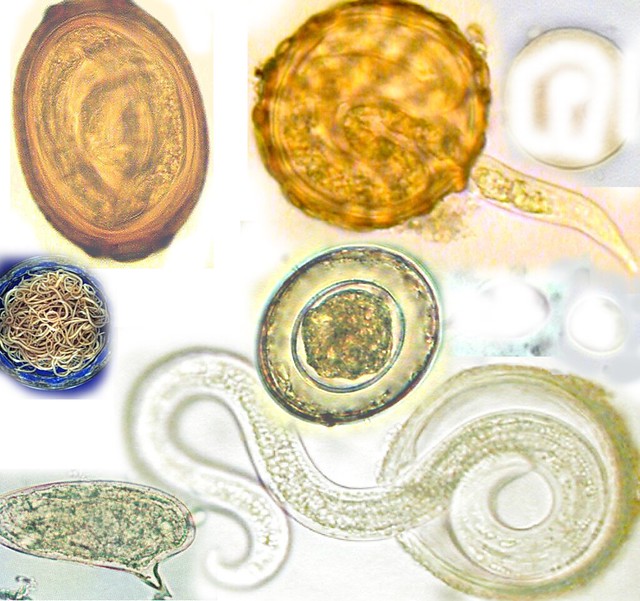
See another one of different types of ova here:
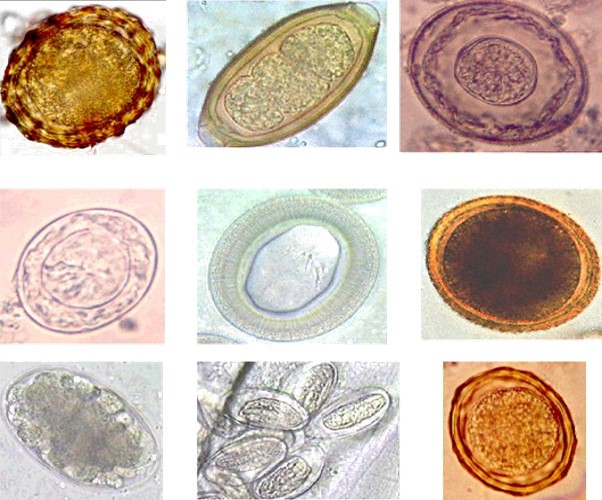
Cati is this you here hard at work:?
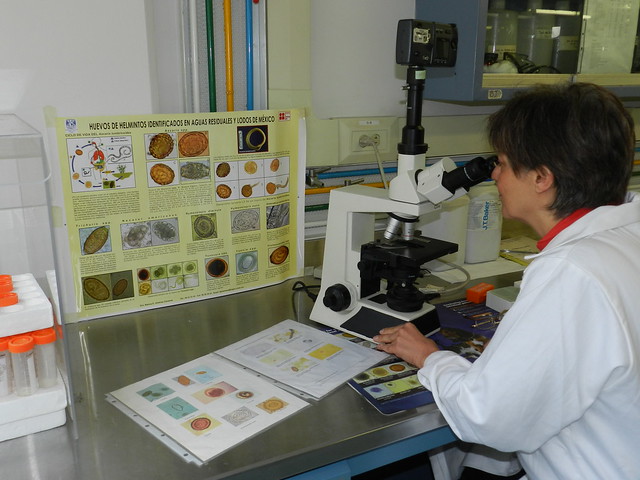
See all the rest of her photos (in three sets) here:
www.flickr.com/photos/gtzecosan/collections/72157609450504284/
Check out our improved Wikipedia article on helminthiasis:
en.wikipedia.org/wiki/Helminthiasis
(more work still remains to be done)
I am still trying to get hold of photos showing the damage that helminths can do to the human body. I have tried all sorts of avenues (like HIFA Dgroup) but no success so far. I am thinking are no doctors taking photos of this infection which affects up to 3.5 billion people??
Here is one but it's an old one (for Guinea worm which is nearly eradicated in most country thanks to the Carter Initiative):

If anyone has such photos and is willing to share them please bring them to my attention. And if anyone knows doctors working with people likely to be infected please check with them if any photos could be taken (with the consent of the patients of course).
Regards,
Elisabeth
P.S. With the restructuring of categories, we now have a sub-sub-category specifically dedicated to helminth infections and helminth ova measurements, see here:
forum.susana.org/forum/categories/159-in...nth-ova-measurements
Freelance consultant on environmental and climate projects
Please Log in to join the conversation.
You need to login to reply- TeamWTR
-
 Topic Author
Topic Author- In the Global Development GCE Phase II, sponsored by Bill & Melinda Gates Foundation, we are the Water Treatment and Reuse Team. Our main project is to develop a software that will identify and quantify helminth eggs.
Less- Posts: 18
- Karma: 3
- Likes received: 10
Re: Software to identify and quantify pathogenic helminth eggs (University Universidad Nacional Autónoma de México (UNAM), Mexico)
Dear Elisabeth
Actually, one person can be infected with more than one species, although it is not common since many species are endemic of certain areas, but the number in the table refers to number of people infected, so a person infected with more than one species would still count as one.
Regards, Cati.
Instituto de Ingeniería (Engineering Institute)
Universidad Nacional Autónoma de México, Mexico City.
E-mails
Blanca Jimenez: This email address is being protected from spambots. You need JavaScript enabled to view it.
Catalina Maya: This email address is being protected from spambots. You need JavaScript enabled to view it.
Jose Antonio Barrios: This email address is being protected from spambots. You need JavaScript enabled to view it.
Please Log in to join the conversation.
You need to login to reply- Elisabeth
-
- User is blocked
- Freelance consultant since 2012
Less- Posts: 3372
- Karma: 54
- Likes received: 932
Re: Software to identify and quantify pathogenic helminth eggs (University Universidad Nacional Autónoma de México (UNAM), Mexico)
I am learning so much about helminth infections from you in this thread, it is really great. Thank you very much!
I just have a small question about the table that you attached above (I attach a modified version of the table, that you sent me by e-mail, below). Maybe it is a silly question.
But you have listed the infections with various types of intestinal worms (helminths) and then added them up. In sum it came to 3.5 billion people - half the global population!
But could it be that the same person is infected with two more more different helminth species, in which case the sum of people infected should be lower? Or is it the case of "once infected with worm A then worm B takes a different host"?)
By the way for the interest of others: Cati and I are currently looking at how to improve the relevant Wikipedia pages on this complex topic, in particular these ones:
en.wikipedia.org/wiki/Helminths
en.wikipedia.org/wiki/Helminthiasis
en.wikipedia.org/wiki/Soil-transmitted_helminthiasis
en.wikipedia.org/wiki/Ascaris
en.wikipedia.org/wiki/Ascariasis
The problem already starts with the naming convention, some people say helminthosis, others say helminthiasis (Cati explained to me that the -osis version would be the preferred one according to some experts who have published about this).
If anyone knows any people who have a special interest in intestinal worms and sanitation, please point them my way (or point them to this thread here) as I need any additional help I can get in getting the information on Wikipedia (which is already very good) in an even better shape (i.e. with more explanations regarding what improved sanitation could do to reduce these infections).
Regards,
Elisabeth
[End of Page 1 of the discussion]
Freelance consultant on environmental and climate projects
This message has an attachment file.
Please log in or register to see it.
Please Log in to join the conversation.
You need to login to reply- TeamWTR
-
 Topic Author
Topic Author- In the Global Development GCE Phase II, sponsored by Bill & Melinda Gates Foundation, we are the Water Treatment and Reuse Team. Our main project is to develop a software that will identify and quantify helminth eggs.
Less- Posts: 18
- Karma: 3
- Likes received: 10
Re: Software to identify and quantify pathogenic helminth eggs (University Universidad Nacional Autónoma de México (UNAM), Mexico)
As you can see, the problem of helminthes is not an easy one, and I would add that even though they are killing all their hosts, they still may cause death in severe cases. The Bill and Melinda Gates are aware of the importance of helminthes worldwide and thus they are working hard to implement solutions on different aspects (detection, treatment, control, etc.).
We are not aware of studies that report the effect of helminthes on immunity for other diseases but we suppose that they may increase the risk of infection due to other microorganisms. We also agree that to break the cycle of this type of parasites, sanitation is not sufficient to control them, it should be accompanied by deworming and educations programs that reduce the risk of people exposed to wastewater and sludge.
With respect to Cholera, the agent responsible of this disease is a bacterium that is not as resistant as helminthes to conventional treatment processes, however, if the infection is not treated on time it may cause death. On the other hand, Ebola is a disease that we are not familiar with and thus would not like to emit an uninformed opinion.
Best regards,
Instituto de Ingeniería (Engineering Institute)
Universidad Nacional Autónoma de México, Mexico City.
E-mails
Blanca Jimenez: This email address is being protected from spambots. You need JavaScript enabled to view it.
Catalina Maya: This email address is being protected from spambots. You need JavaScript enabled to view it.
Jose Antonio Barrios: This email address is being protected from spambots. You need JavaScript enabled to view it.
Please Log in to join the conversation.
You need to login to replyRe: Software to identify and quantify pathogenic helminth eggs (University Universidad Nacional Autónoma de México (UNAM), Mexico)
When it comes to deworming a community, this is much more than a challenge for medical doctors. All the "other" vectors and sources need to be covered including soil surfaces, yards, toilets, septic tanks, sewer pipes, etc. So practices like open defecation, dumping of collected faecal sludge in open areas and ditches and discharge of untreated wastewater, septage and sewerage are all suspected vectors of transmission.
Add pathogens like Cholera to these rather "open" systems and the risk of widespread epidemics can be explained. What then are the risks of Ebola spreading among members of communities knowing how dysfunctional these systems are.
Stockholm Environment Institute
This email address is being protected from spambots. You need JavaScript enabled to view it.
www.sei.org
www.ecosanres.org
Please Log in to join the conversation.
You need to login to reply- TeamWTR
-
 Topic Author
Topic Author- In the Global Development GCE Phase II, sponsored by Bill & Melinda Gates Foundation, we are the Water Treatment and Reuse Team. Our main project is to develop a software that will identify and quantify helminth eggs.
Less- Posts: 18
- Karma: 3
- Likes received: 10
Re: Software to identify and quantify pathogenic helminth eggs (University Universidad Nacional Autónoma de México (UNAM), Mexico)
You have reason about the 5 million, this does not correct, the "precise" number is 3,500 million (3.5 billion).
We included a table with information about this number of worldwide´s infections by helminthiases.
In this moment we are working with the validation of the final system.
Regards and thanks for your note.
WTR Team
Please log in or register to see it.
Instituto de Ingeniería (Engineering Institute)
Universidad Nacional Autónoma de México, Mexico City.
E-mails
Blanca Jimenez: This email address is being protected from spambots. You need JavaScript enabled to view it.
Catalina Maya: This email address is being protected from spambots. You need JavaScript enabled to view it.
Jose Antonio Barrios: This email address is being protected from spambots. You need JavaScript enabled to view it.
This message has an attachment file.
Please log in or register to see it.
Please Log in to join the conversation.
You need to login to replyRe: Software to identify and quantify pathogenic helminth eggs (University Universidad Nacional Autónoma de México (UNAM), Mexico)
Thanks for the news on automated image analysis of Helminth eggs and the Perez Sanchez thesis. Is this method now being used routinely in Mexico?
I noticed in your article from 2009 "Helminth ova control in wastewater and sludge for advanced and conventional sanitation" (www2.gtz.de/Dokumente/oe44/ecosan/en-hel...-wastewater-2007.pdf) you write that there are some 5 million people with Helminth infections. How does this compare with the estimated number by WHO which is so much higher at 2 billion. www.who.int/mediacentre/factsheets/fs366/en/ Could be you were referring to Ascaris only?
My thesis is that hygiene and treatment of faeces remain so poor across the developing world that this monster has just kept growing for the past 50 years even with some concerted deworming programmes. This is by far the single most widespread public health problem dwarfing all others.
Easier and automated monitoring may help lead to more measurements to better determine risk. Hopefully this will motivate communities to push for more stringent sanitation and hygiene.
Stockholm Environment Institute
This email address is being protected from spambots. You need JavaScript enabled to view it.
www.sei.org
www.ecosanres.org
Please Log in to join the conversation.
You need to login to reply- Forum
- categories
- Sanitation systems
- Faecal sludge management (FSM)
- Determining helminth egg quantities (measurement techniques)
- Software to identify and quantify pathogenic helminth eggs (National University of Mexico)







